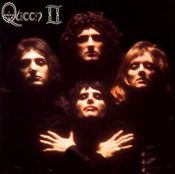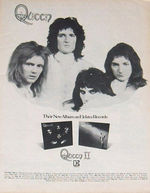From Queenpedia.com
As soon as sessions for Queen finished in March 1973, the band took a brief break before jumping back into the studios to work on their follow-up. The creatively fertile band, bursting with ideas, entered Trident Studios in August to lay down songs that would become their second album, unimaginatively titled Queen II. (Brian later admitted that the band considered calling it Over The Top, but this idea was discarded.) In addition to songs that had been written around the same time as those that appeared on the debut album (including Father To Son, Ogre Battle, and Seven Seas Of Rhye), as well as an older song written by Brian during his days in Smile (White Queen (As It Began)), songs were written that were far more adventurous than anything attempted before. Part of this creativity was due to the need to distinguish themselves from other bands of the time. Glam rock was an ever-emerging form of rock 'n' roll, and with David Bowie and Roxy Music releasing albums that would define the genre (Aladdin Sane and For Your Pleasure, respectively), suddenly this style was becoming popular. Mott the Hoople became the ultimate glam rock band of the 1970s (second only to T. Rex); interestingly, Queen would support Mott on their winter 1973 UK tour, and again on their spring 1974 US tour. And it shouldn't go unmentioned that the band had approached Mr. Bowie to produce Queen II, but the chameleon rocker had to decline; their only collaboration wouldn't come until eight years later. Concept albums were also a burgeoning fad, especially with the March 1973 release of Pink Floyd's Dark Side Of The Moon; while Queen II isn't strictly conceptual, there's a definite theme running through the songs, which was confirmed, however indirectly, when it was decided to place all of Brian's songs – and Roger's sole contribution, The Loser In The End – on the first side (titled "Side White") and all of Freddie's songs on the second side (titled "Side Black"). The first side is introspective and introverted, as befits Brian's songwriting style; the multitracked Procession forms a dirge-like introduction to the album, leading into the piano arpeggios of Father To Son, influenced in various ways by The Who and Led Zeppelin. White Queen (As It Began) follows, and is probably one of Brian's most startling and poignant ballads ever, before leading into the self-sung Some Day, One Day, which makes mention of misty castles and potential queen-hood; this faerytale adventure would be further explored in Freddie's songs. The Loser In The End, which many fans consider to be ill-placed, rounds out the second side, and is another track heavily influenced by The Who. Freddie's songs form a medley, with each song segueing in and out of each other effortlessly, each song more complex than the last: starting with the frenetic Ogre Battle and leading into the lighthearted The Fairy Feller's Master-Stroke (inspired by Richard Dadd's painting of the same name), the plaintive ballad Nevermore blends into the magnum opus The March Of The Black Queen, which would be a harbringer of a particular mock opera two albums later. The decidedly Beach Boys-influenced Funny How Love Is is the oddly-placed conclusion of the suite, with Seven Seas Of Rhye added for good measure. Instrumentally, the band were more keen on exploring and experimenting: apart from the standard line-up of drums, bass, and guitar, various keyboard instruments were used – Hammond organ and marimba on The Loser In The End, harpsichord on Father To Son and The Fairy Feller's Master-Stroke – as well as percussion – tubular bells and castanets on The March Of The Black Queen. The sound, too, is more lush and expansive than the debut: acoustic guitars are used prominently to double up a rhythm, in a method first perfected by The Rolling Stones and The Who in the 1960s. Part of the sound has to do with the addition of Robin Geoffrey Cable as co-producer for a handful of tracks, though Roy Thomas Baker was also willing to push the envelope in ways that he hadn't been able to on the debut album. Released in March 1974 (delayed significantly due to an oil shortage as well as a cover misprint) to expectedly mixed reviews, the album peaked at No. 5 in the UK and No. 49 in the US, while the sole single release, Seven Seas Of Rhye, reached No. 10 in the UK. The album was wrapped in an iconic sleeve by Mick Rock: with the band posed in a clockwork fashion, maximum use of light and shade was used to create a moody appearance. The band were so enamored with this image that it was used for the Bohemian Rhapsody promotional video the following year. Inside was a lighter photograph of a wide-eyed, young-looking band (mirroring the front cover), resplendent in white fineries. (Oh, and John Deacon's name had finally been reverted from the inside-jokey "Deacon John" to its normal way around.) By this time, the band had become experienced live musicians, and were just about to embark on their first US tour; yet that spring, Queen almost ceased to exist. The album was rereleased by Hollywood Records in 1991, adding the non-album B-side single See What A Fool I've Been (based off a Sonny Terry & Brownie McGhee song, 'That's How I Feel', and written by Brian during his days in Smile) as well as two remixes: a fairly straightforward one of Ogre Battle, and an insipid dance remix of Seven Seas Of Rhye (yet it was baffingly met with high approval from Freddie). Tracklists
Credits
Charts
Information supplied by Fedepeti, 24 August 2004 Singles
Queen Talks
Reviews
Promotional Material |
|||||||||||||||||||||||||||||||||||||||||||||||||||||||||||||||||||||||||||||||||||||||||||||||||










































